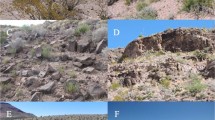Summary
We develop a model for the distribution of animals around encounter sites. It is particularly applicable to males attending mate-encounter sites, such as hilltops. Major predictions are: male distributions should be unstable; males should show little site tenacity, particularly when at low densities; males with low probability of mate capture should occupy subordinate positions; probability of mate capture is a better predictor of position than resource-holding potential; female choice favours despotic distributions; males should often patrol together. Several of these predictions are met, others are testable. We identify some parameters that should be more extensively studied.
Similar content being viewed by others
References
Alcock J (1979) The behavioral consequences of size variation among males of the territorial wasp Hemipepsis ustulata (Hymenoptera: Pompilidae). Behaviour 71:322–335
Alcock J (1983a) Territoriality by hilltopping males of the great purple hairstreak, Atlides halesus (Lepidoptera: Lycaenidae): Convergent evolution with a pompilid wasp. Behav Ecol Sociobiol 13:57–62
Alcock J (1983b) Consistency in the relative attractiveness of a set of landmark territorial sites for two generations of male tarantula hawk wasps (Hymenoptera: Pompilidae). Anim Behav 31:74–80
Alcock J (1984) Convergent evolution in perching and patrolling site preferences of some hilltopping insects of the Sonoran Desert. Southwest Nat 29:475–480
Alcock J, Alcock JP (1983) Male behavior in two bumblebees Bombus nevadensis auricomus and B. grisicollis (Hymenoptera: Apidae). J Zool 200:561–570
Alcock J, Jones CE, Buchmann SL (1977) Male mating strategies in the bee Centris pallida Fox (Anthophoridae: Hymenoptera). Am Nat 111:145–155
Andersson M (1980) Female choice selects for extreme tail length in a widowbird. Nature 299:818–820
Baker RR (1972) Territorial behaviour of the nymphalid butterflies Aglais urticae L. and Inachis io L. J Anim Ecol 41:453–470
Campanella PJ, Wolf LL (1974) Temporal leks as a mating system in a temperate zone dragonfly 1. Plathemis lydia (Drury). Behaviour 51:49–87
Courtney SP (1980) Studies on the biology of the butterflies Anthocharis cardamines (L.) and Pieris napi (L.) in relation to speciation in Pieridae. PhD thesis, University of Durham, England
Courtney SP, Parker GA (1985) Mating behaviour of the tiger blue butterfly (Tarucus theophrastus): Competitive matesearching when not all females are captured. Behav Ecol Sociobiol 17:213–221
Davies NB (1978) Territorial defence in the speckled wood butterfly (Pararge aegeria), the resident always wins. Anim Behav 26:138–147
Fisher RA (1930) The genetical theory of natural selection. Oxford Univ Press, Oxford
Fretwell SD, Lucas HL (1970) On territorial behaviour and other factors influencing habitat distribution in birds. Acta Biother 19:16–36
Harper D (1982) Competitive foraging in mallards: ‘ideal free’ ducks. Anim Behav 30:575–584
Lederhouse RC (1982) Territorial defence and lek behaviour of the black swallowtail butterfly Papilio polyxenes. Behav Ecol Sociobiol 10:109–118
Lefebvre L (1983) Equilibrium distribution of feral pigeons at multiple food sources. Behav Ecol Sociobiol 12:11–17
Maynard-Smith J (1982) Evolution and the theory of games. Cambridge Univ Press
Maynard Smith J, Price GR (1973) The logic of animal conflict. Nature 246:15–18
Milinski M (1979) An evolutionarily stable feeding strategy in sticklebacks. Z Tierpsychol 51:36–40
Otronen M (1984) The effect of differences in body size on the male territorial system of the fly Dryomyza anilis. Anim Behav 32:882–890
Parker GA (1970) The reproductive behaviour and the nature of sexual selection in Scatophaga stercoraria L. (Diptera: Scatophagidae) II. The fertilization rate and the spatial and temporal relationship of each sex around the site of mating and oviposition. J Anim Ecol 39:205–228
Parker GA (1974) IX. Spatial distribution of fertilization rates and evolution of male search strategy within the reproductive area. Evolution 28:93–108
Parker GA (1978) Evolution of competitive mate searching. Ann Rev Entomol 23:173–196
Shapiro AM (1986) Behavioral and ecological observations on Peruvian high Andean Pieridae. Stud Neotrop Fauna Envt 20
Shields O (1967) Hilltopping. J Res Lep 6:69–178
Tagawa J, Kitano H (1981) Mating behavior of the Braconid wasp, Apanteles glomeratus L. (Hymneoptera: Braconidae) in the field. Appl Entomol Zool 16:345–350
Waser PM (1981) Sociality or territorial defense? The influence of resource renewal. Behav Ecol Sociobiol 8:231–237
Weatherhead PJ, Robertson RJ (1979) Offspring quality and the polygyny threshold: “The sexy son hypothesis”. Am Nat 113:201–208
Wickman P-O, Wiklund C (1983) Territorial defence and its seasonal decline in the speckled wood butterfly (Pararge aegeria). Anim Behav 31:1206–1216
Author information
Authors and Affiliations
Rights and permissions
About this article
Cite this article
Courtney, S.P., Anderson, K. Behaviour around encounter sites. Behav Ecol Sociobiol 19, 241–248 (1986). https://doi.org/10.1007/BF00300638
Received:
Accepted:
Issue Date:
DOI: https://doi.org/10.1007/BF00300638




